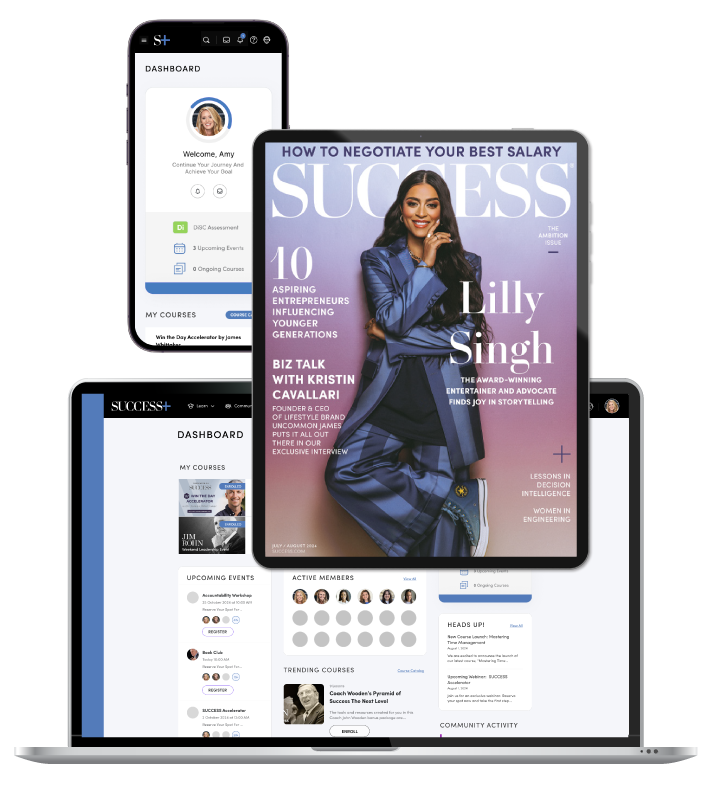What You’ll Learn: Learn eight key steps on how to write a keynote speech that really grabs your audience and keeps them engaged. Plus, get examples and tips to help you deliver an incredible speech.
A keynote speech is a high-impact presentation. It’s typically delivered at major events and aligns with the event’s central theme or purpose. No matter what topic you are speaking on, learning how to write a keynote speech involves key steps. These include understanding your audience, defining your message, creating a strong opening, adding personal touches, and including a call to action. It’s also important to practice your delivery. With preparation and thought, it can provide valuable information and leave a lasting impression.
Yet delivering a keynote speech can seem daunting. How can you speak authoritatively about your own ideas for up to an hour? How do you know what ideas your audience will latch onto? How can you hold dozens or hundreds of people’s attention for that much time?
If you’ve been tasked with preparing a keynote speech, questions like these are probably burning in your mind. It’s a major responsibility, but also a great privilege for you to highlight your expertise. The best kinds of keynotes don’t simply deliver information, but connect with audiences and deliver a thematic idea that stays with listeners for months or years afterwards.
If you’re feeling the weight of preparing a major speech, we’re here to help. We’ve created a practical guide to preparing a keynote speech that resonates with your audience and establishes your credibility—giving you the tools to be a more confident speaker. To start, we’ll review what a keynote speech is, break down each step that is taken to properly write a keynote speech and then share famous speeches that you can emulate yourself.
What Is a Keynote Speech?
A keynote speech is the information highlight of an event or conference. It’s usually set at the beginning or end, designed to deliver a central message in line with a predetermined theme. These speeches are typically longer than normal presentations, and therefore give speakers more flexibility to explain a topic thoroughly.
While the line between a keynote and other presentations can be blurry, a keynote typically centers on a unifying theme that ties the event together. If you were speaking at a conference on proper business management as the keynote speaker, you would be tasked with speaking on a topic that connects the overall theme of the conference to the audience.
A successful keynote speech is a talk that seizes the audience’s attention in both intellectual and emotional ways. It leaves them with a key insight about themselves, the theme of the event or the topic spoken on. Let’s look at how to write a speech that checks those boxes.
How to Write an Incredible Keynote Speech With Impact
Now that we’ve discussed what a keynote speech is, let’s look at how to create one. Below are some general steps to help you get started on writing a compelling keynote address. Keep in mind that everyone’s writing process is unique. The following steps serve only as a guideline in your writing process, not a series of rules to be followed.
Step 1: Know Your Audience and Event Theme
A keynote speech is a talk for your audience to gain insights, not just for you to express them. Because your audience comes first, you need to structure your speech around their needs. If you’re speaking at a conference or other themed event, find out what the overall theme is. This theme will guide your core idea.
Once you understand the event theme, you need to understand your audience as well. Think about who will be listening to your talk and what they might be hoping to glean from your speech. Ask key questions about your audience, such as:
- Who are they (e.g., age, occupation)?
- Why are they attending the conference/event?
- What do they need right now professionally and personally?
- What are their professional backgrounds?
Knowing your audience’s desires and professional situation equips you to create a speech that is both informative and resonant—key ingredients of a great keynote address.
Step 2: Define Your Core Message
Your speech needs to have a single big idea or core message known as a “throughline.” This is a concept or narrative that runs through your speech and guides its overall structure. Ideally, you should be able to sum up the throughline of your message in a single sentence.
If you’re delivering a speech at a themed event, your throughline must be closely aligned with the event’s overall theme. For example, if the event theme was developing business resiliency, your throughline could be about how you created resiliency in your business by developing authentic relationships.
Make sure this core message is important to your readers and important to you. If your expertise doesn’t line up with the throughline you’ve drawn, you might need to tweak it.
Step 3: Brainstorm Ideas
Before developing any of the sub-arguments or ideas that support your overall theme, take time to brainstorm ideas to see where your expertise shines light on the topic. Write down any and all ideas that come bubbling up to the surface when you think about the throughline you’ve created. What areas of your professional and/or personal past relate to the theme most closely?
One helpful way to begin brainstorming is to create a mind map of the speech, with your central theme in the middle. Try to come up with as many personal anecdotes, facts, arguments, ideas, and talking points as you can that branch off that main throughline. These ideas will then form your key points and arguments that support your speech’s theme throughout your talk.
Step 4: Open With Impact
Writing the introduction of a keynote address can be one of the most difficult parts of creating a compelling speech. You need to capture the audience’s attention in seconds and then hold it. Don’t open your speech discussing yourself and your qualifications.
Start your speech with something that connects with your audience right away. This could be a personal anecdote, statistics about a problem most members of the audience face, or the beginning of a story.
Step 5: Structure Your Speech With 2–3 Key Points
As you are honing in on how to write a keynote speech, keep in mind that structure matters. Using the ideas you generated in your brainstorming session, come up with two or three talking points that support your speech’s throughline. Don’t do more than three, as that creates unneeded complexity for your audience. It can also reduce their ability to focus on the core idea that matters.
These key points explore and argue for your speech’s key throughline and need to be in areas you have the most expertise and insight in. If you don’t feel confident or excited about a key point in your speech, discard it and look for another. These key points should also be based on your audience’s needs—needs that you would have uncovered in step one of this process.
Step 6: Add Personal Stories and Emotion
Even if you’ve already included anecdotes, take a moment to ask yourself: Am I truly being authentic? Emotional honesty and real stories are what make your message memorable. Remember, you aren’t trying to simply explain a key concept; you’re trying to connect with people first. Then once you’ve connected, you deliver a powerful insight to change their professional lives. You can’t connect with the audience unless you have stories or real emotion in your speech.
Storytelling is an integral part of any great keynote speech. Don’t leave it out of yours.
Step 7: Close With a Call to Action or Takeaway
While a keynote speech is meant to inspire, inspiration without a goal or direction is useless energy. Your speech needs to inspire others about the core message and then drive them to act or think differently when you close. Clarity is very important at this stage of your speech—your audience should not be left wondering what they need to do or think next.
Some simple ways you can close well include:
- Wrapping up a story you told throughout the speech to bring home a point
- Ending with a key statistic or important metric to guide thoughts/actions
- Return to the beginning phrase of your speech to remind the audience how they got here
Step 8: Practice and Refine
At this point in the writing process, you likely have a solid rough draft to work with. Now it’s time to refine and practice your speech.
Present your speech multiple times at a similar venue or rehearsal space if you can. This will get you prepared for what it will be like to give your real speech and how the space feels. For the first few practice sessions, go over your entire speech to see where you have areas of difficulty. Then, only focus on those areas to use your time efficiently.
If you can, practice with a peer who has speaking experience. They can give you helpful advice and point out blind spots that you might not be able to notice.
Quick Tip: Nervous about delivering your presentation? You’re not alone. Check out our guide to overcoming a fear of public speaking to handle your speech with confidence and ease.
How Long Are Keynote Speeches?
The exact length of a keynote depends on the event. If you’re giving a weekend conference opening speech, you could be speaking for 45 minutes to an hour. An evening event speech might only be 10-20 minutes.
Ultimately, the best way to determine your keynote’s length is to speak with the event organizers. Your event and your audience guide the length of your speech, but there are some exceptions.
If the event organizers give you a timeline that seems too short or too long, don’t be afraid to share your opinion, though. As the subject-matter expert, you know how much time you need to deliver your message effectively.
Keynote Speech Examples for Inspiration
Often, the best way to learn how to write a keynote speech is by seeing one in action. Here are some examples of profound keynote speeches and a brief explanation of what made them so memorable.
| Keynote Speech | Key Focal Point |
| Steve Jobs’ Commencement Address – Stanford University | Jobs uses a blend of humor and narrative to drive home critical lessons relevant for his audience of new graduates. |
| Mel Robbins’ TEDx Talk – How to Not Screw Yourself Over | Robbins uses emotionally intelligent techniques to connect with her audience and help them tap into her passion. |
| Susan Cain’s TED Talk – The Power of Introverts | Cain shows how a calm stage presence combined with passionate narratives can keep an audience engaged. |
Interested in seeing more motivational speeches? Check our roster of six motivational commencement speeches.
Delivering a Keynote That Resonates
Delivering a keynote speech that deeply connects and empowers audiences can be challenging. But, with proper preparation, practice, and discipline, you can learn how to write a keynote speech that connects and clarifies key ideas. Enhance the event, inspire your audience, deliver valuable information, and connect with the audience in a powerful way. It may even help you continue to build your brand or lead you to further success.
If you’re ready to crush your goals and take them to the next level, check out our Goal-Setting Ebook for powerful insights and practical strategies today.
Photo from Matej Kastelic/Shutterstock.com











